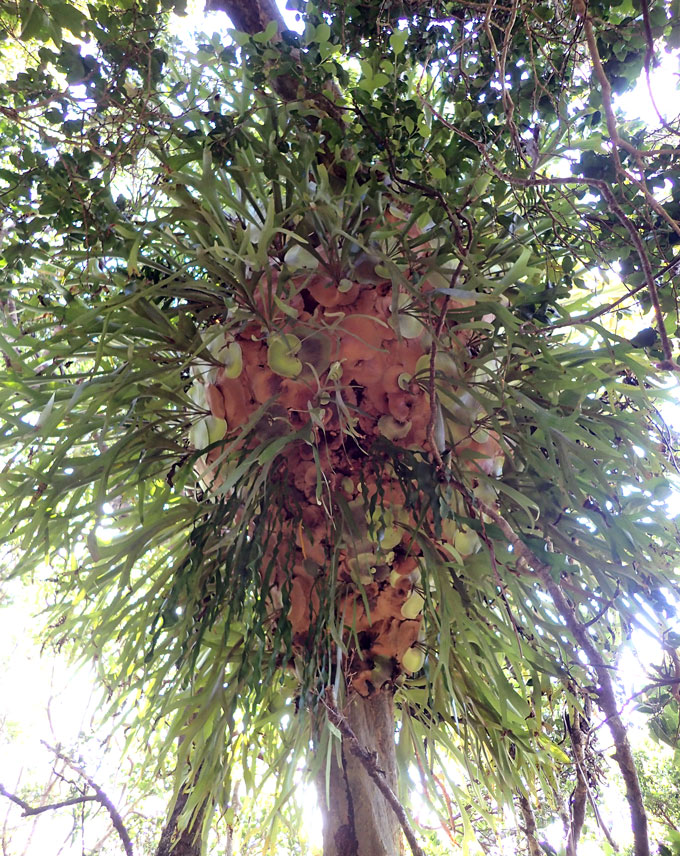High in the forest canopy, a mass of strange ferns grips a tree trunk, looking like a giant tangle of floppy, viridescent antlers. Below these fork-leaved fronds and closer into the core of the lush knot are brown, disk-shaped plants. These, too, are ferns of the very same species.
The ferns — and possibly similar plants — may form a type of complex, interdependent society previously considered limited to animals like ants and termites, researchers report online May 14 in Ecology.
Kevin Burns, a biologist at Victoria University of Wellington in New Zealand, first became familiar with the ferns while conducting fieldwork on Lord Howe Island, an isolated island between Australia and New Zealand. He happened to take note of the local epiphytes — plants that grow upon other plants — and one species particularly caught his attention: the staghorn fern (Platycerium bifurcatum), also native to parts of mainland Australia and Indonesia.
“I realized, God, you know, they never occur alone,” says Burns, noting that some of the larger clusters of ferns were massive clumps made of hundreds of individuals.
It was soon clear to Burns that “each one of those individuals was doing a different thing.”
He likens the fern colonies to an upside-down umbrella made of plants. Ferns with long, green, waxy “strap” fronds appeared to deflect water to the center of the aggregation, where disk-shaped, brown, spongey “nest” fronds could soak it up.
 A colony of common staghorn ferns (Platycerium bifurcatum) grows in the forest canopy on an island cedar tree (Guioa coriacea), its brown, absorbent nest fronds at the bottom and core of the colony, and green strap fronds projecting outwards.Ian Hutton
A colony of common staghorn ferns (Platycerium bifurcatum) grows in the forest canopy on an island cedar tree (Guioa coriacea), its brown, absorbent nest fronds at the bottom and core of the colony, and green strap fronds projecting outwards.Ian Hutton
The shrubby apparatus reminded Burns of a termite mound, with a communal store of resources and the segregation of different jobs in the colony. Scientists call these types of cooperative groups, where overlapping generations live together and form castes to divide labor and reproductive roles, “eusocial.” The term has been used to describe certain insect and crustacean societies, along with two mole rat species as the only mammalian examples (SN: 10/18/04). Burns wondered if the ferns could also be eusocial.
His team’s analysis of frond fertility revealed 40 percent couldn’t reproduce, and the sterile colony members were predominantly nest fronds. This suggests a reproductive division of labor between the nest and strap frond types. Tests of the fronds’ absorbency confirmed that nest fronds sop up more water than strap fronds do. Previous research by other scientists found networks of roots running throughout the colony, which means that nest fronds have the ability to slake strap fronds’ thirst. The fronds divided labor, much like ants and termites.
The team also analyzed genetic samples from 10 colonies on Lord Howe Island and found that eight were composed of genetically identical individuals, while two contained ferns of differing genetic origins. High degrees of genetic relatedness are also seen in colonies of eusocial insects, where many sisters contribute to the survival of the nest.
Taken together, Burns thinks these traits tick many of the boxes for eusociality. That would be a “big deal,” he says.
An assumed requirement for eusocial colonial living is behavioral coordination, because it allows different individuals to work together. But ferns are plants, not animals, which so often coordinate their behaviors. Seeing eusocial living in plants “seems to indicate to me that this type of transition in the evolution of complexity doesn’t require a brain,” Burns says.
The study opens up the “opportunity to look at [epiphytes] with the lens of eusociality,” which is “really cool,” says Michelle Spicer, an ecologist at the University of Puget Sound in Washington who was not involved with this study.
Spicer points out that water and nutrient exchange is known in other epiphytic plants. Though, Burns notes that the division of labor to build communal resources “appears to be a key feature that sets staghorn [ferns] apart from other colonial plants.”

Sign Up For the Latest from Science News
Headlines and summaries of the latest Science News articles, delivered to your inbox
Client key* E-mail Address* Go
Thank you for signing up!
There was a problem signing you up.
A stressful life in the canopy — far away from the soil — may have contributed to the ferns’ evolution of eusociality by providing water and nutrient security, Burns says.
“The epiphyte lifestyle certainly facilitates group living, and group living is where all social stories start,” says Brian Whyte, an evolutionary biologist at the University of California, Berkeley also not involved with this research.
These ferns could certainly fit the definition of eusociality, Whyte says. He is particularly fascinated by how the plants form castes and colonies in the wild but remain as individual strap fronds when grown in soil as ornamental plants. This variability differs from many eusocial species, he says.
Burns and his colleagues are currently investigating if strap fronds can become nest fronds after being transplanted to another part of the colony. Burns also wants to study another staghorn fern species in Madagascar that appears to also grow in colonies.
Whyte sees major benefits in broadening a view of eusociality to include plants.
“It’s so nice to be able to notice something and be like ‘wait, this is comparable to some of the coolest, most advanced societies in the living world,’” he says. Regardless of where the ferns sit on the eusociality spectrum, he notes, they still have intriguing similarities and differences to caste-forming animals. “Learning more about [these ferns] will improve our theories on why these characteristics have evolved across the diversity of life.”

